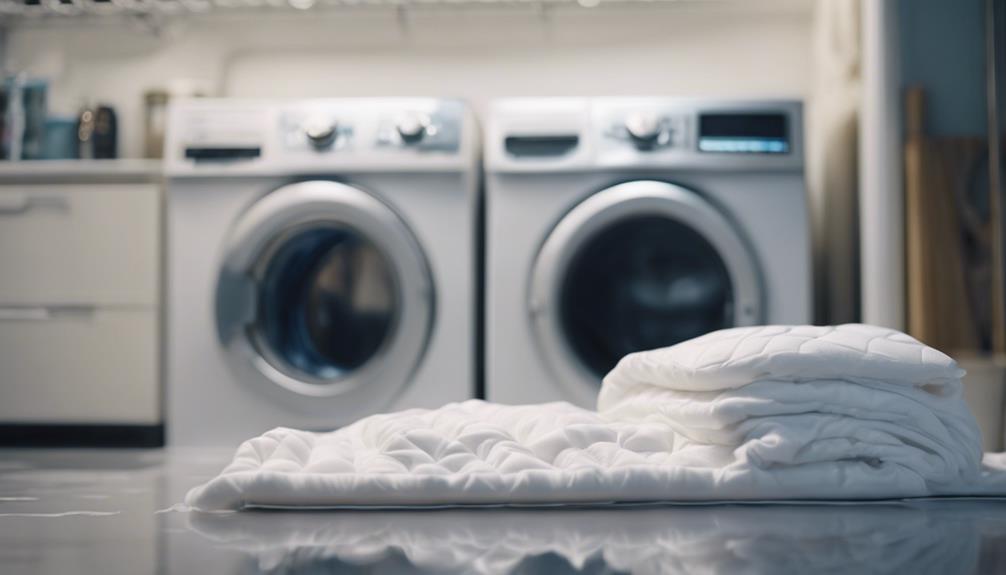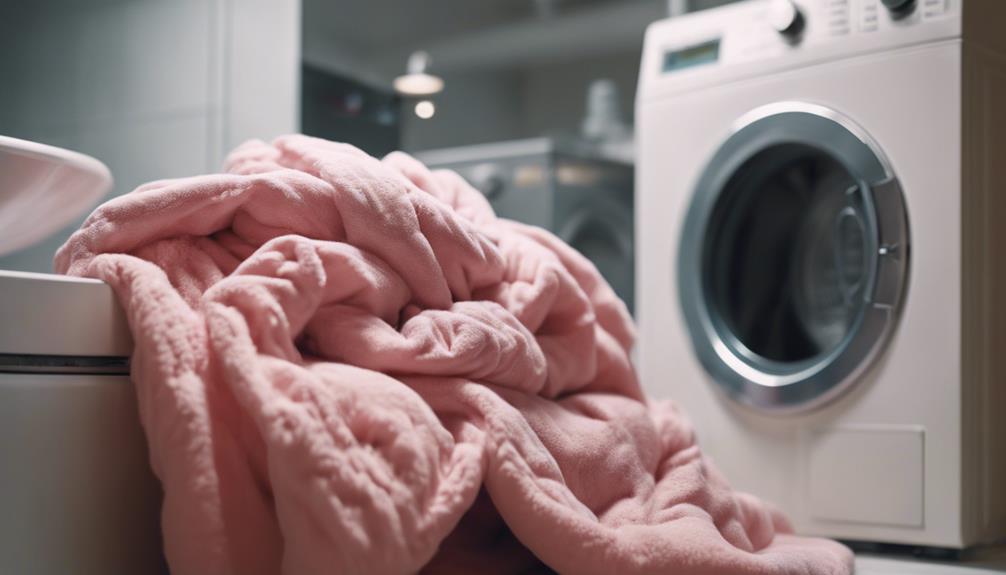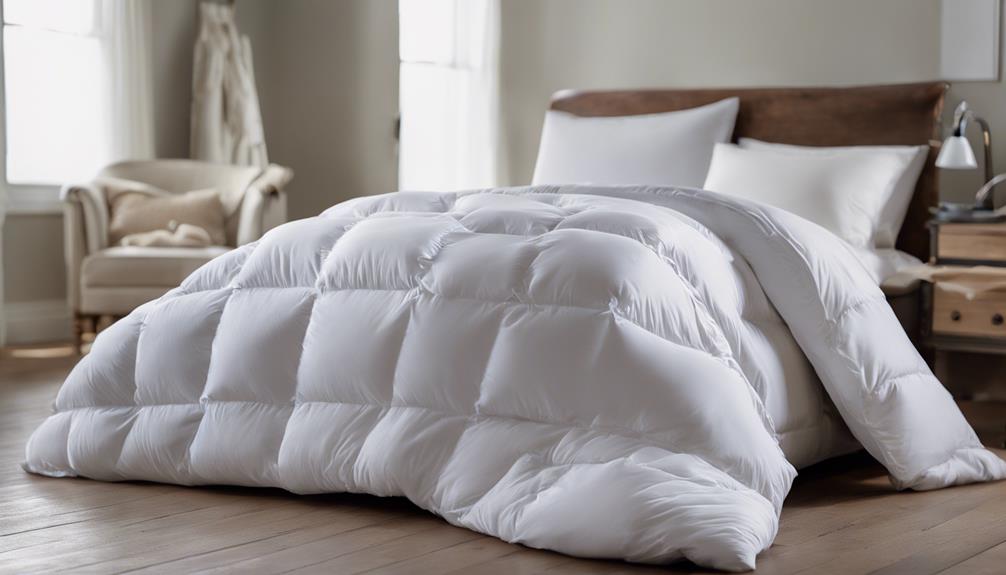Dogs may urinate on down comforters due to excitement, anxiety, marking territory, or stress. These behaviors indicate underlying issues that need training and attention. Reasons can include fear, insecurity, and medical conditions. Training and providing a stress-free environment are crucial for preventing accidents. Signs such as excessive barking, destructive behaviors, or changes in appetite may indicate deeper problems. Creating a calming environment and sticking to a routine can help address stressors. It’s important to consult a vet for any health issues that may be affecting your dog’s urination habits. For more information on preventing accidents and creating a secure home environment for your dog, continue reading below.
Key Takeaways
- Soft and inviting texture of down comforters attracts dogs.
- Anxiety or stress can lead to peeing on bedding.
- Environmental triggers like moving or loud noises may cause accidents.
- Lack of bladder control in young dogs is a common reason.
- Territorial marking behavior can prompt peeing on down comforters.
Understanding Reasons for Peeing Behavior
Understanding the reasons why dogs pee on down comforters is important for effectively addressing and preventing this behavior. Dogs may urinate on bedding due to various reasons such as excitement, submission, marking territory, fear, anxiety, stress, changes in the living environment, or medical conditions.
It's vital to recognize that dog pee on down comforters can be a sign of underlying issues that need attention. By identifying the root cause of this behavior, pet owners can take appropriate steps to address it. Training and positive reinforcement play a significant role in preventing dogs from urinating on bedding.
Creating a consistent routine, providing a comfortable and stress-free environment, and offering proper bathroom breaks can help reduce the chances of finding dog pee on down comforters. Regular maintenance, cleaning, and training are key elements in keeping bedding free from unwanted accidents.
Signs of Anxiety in Dogs
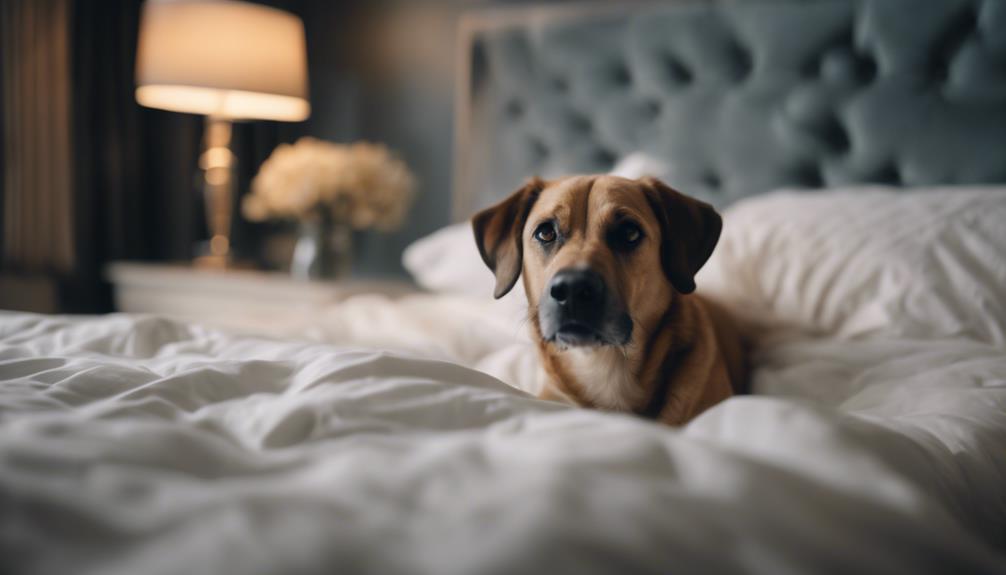
Exploring the behavior of dogs urinating on down comforters reveals key signs of anxiety in these animals. When a dog starts to exhibit excessive barking, panting, or pacing, it could be a significant indication of anxiety.
Destructive behaviors like chewing or digging may also signal that the dog is under stress. Additionally, avoidance behaviors such as hiding or cowering could be a red flag for anxiety issues. Aggression towards people or other animals is another way anxiety might manifest in dogs.
Keep an eye out for any changes in your dog's appetite, sleep patterns, or overall demeanor, as these could suggest underlying anxiety. Remember, dogs use behaviors like urinating to communicate, so understanding the signs of anxiety is vital for providing them with the support and care they need.
Impact of Territorial Marking

Peering into the behavior of dogs, one can observe how territorial marking through urination impacts their interactions with the environment. Territorial marking is an essential behavior in dogs, stemming from their ancestral roots. When a dog pees on a down comforter, it's staking a claim on that particular spot, signaling to other animals that this territory is theirs. This behavior isn't limited to down comforters; dogs may mark various objects or areas in their surroundings, especially when they feel threatened or insecure. For older dogs, territorial marking can sometimes increase due to changes in their surroundings or the introduction of new pets into the household.
Understanding the significance of territorial marking is vital in addressing issues related to dogs peeing on down comforters. By acknowledging the underlying reasons behind this behavior, pet owners can take proactive steps to manage and prevent such incidents. Training techniques and environmental adjustments can be effective in deterring dogs from marking their territory in undesirable places.
Training Techniques to Prevent Peeing
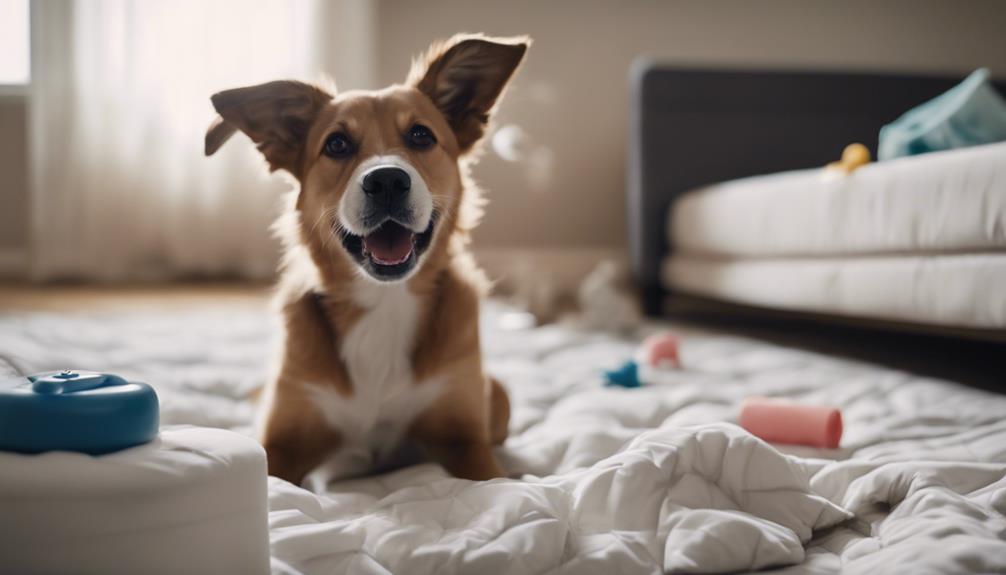
When it comes to preventing dogs from peeing in inappropriate places, using consistent outdoor potty training routines is key.
Positive reinforcement, like praise and treats, can also help encourage proper elimination behavior.
It's important to avoid punishment-based methods as they can make the behavior worse.
Potty Training Methods
To effectively prevent indoor accidents and reinforce proper elimination habits in dogs, consistent outdoor potty training routines must be established. Positive reinforcement, like praise or treats, can encourage dogs to pee in designated outdoor areas. It's important to avoid punishment-based methods, as these can worsen behavior and hinder training progress.
Crate training is effective for preventing accidents when dogs are unsupervised or at night. If potty training issues persist despite consistent efforts at home, seeking professional guidance may be necessary. By establishing a routine and using positive reinforcement techniques, you can help your dog develop good potty habits and reduce indoor accidents.
Consistent Routine Reinforcement
Establishing a consistent routine is key to reinforcing proper elimination habits in dogs and preventing indoor accidents. Consistent outdoor potty training routines help dogs understand where it's appropriate to pee.
Positive reinforcement, like praise or treats, encourages dogs to pee in the right places. Punishment-based methods can make inappropriate peeing worse, so it's best to avoid them.
Crate training can be useful to prevent accidents when dogs are left unsupervised. If training efforts don't work, seeking professional guidance is a good idea.
Health Conditions and Peeing Habits

Health conditions can greatly affect a dog's peeing habits, such as urinary tract infections causing discomfort. Sometimes, dogs urinate on bedding like down comforters due to pain from underlying health issues.
It's important to observe any changes in peeing behavior as they might indicate a need for veterinary care.
Medical Issues Affecting Peeing
When considering dogs' peeing habits, it's important to recognize that underlying health issues can greatly impact their urinary behavior. Urinary tract infections (UTIs) are one such medical problem that can lead to changes in a dog's peeing habits. Dogs with UTIs may experience increased frequency of urination, discomfort while peeing, and even accidents in inappropriate places like down comforters.
Monitoring any alterations in your dog's peeing routine is significant, as it can be a sign of an underlying health condition. Regular veterinary check-ups are important to detect and address medical issues affecting your dog's urinary behavior promptly. Remember, dietary factors and medications can also influence a dog's peeing habits, so it's necessary to consult with a veterinarian for proper diagnosis and treatment.
Behavioral Reasons for Peeing
Understanding the various behavioral triggers and health concerns can shed light on why dogs may pee on down comforters. Dogs may exhibit this behavior due to stress and anxiety, which can be caused by changes in their environment, separation from their owners, or even loud noises. Health conditions like urinary tract infections may also lead to inappropriate urination on bedding.
Some dogs may have a preference for the texture or scent of down comforters, making them a target for peeing. It's essential to address these behavioral issues and health problems to prevent dogs from peeing on bedding. Monitoring their habits, providing proper training, and creating a comfortable environment can help manage and correct this behavior.
Training and Prevention Strategies
To prevent dogs from peeing on down comforters, we focus on training and implementing prevention strategies targeting both health conditions and peeing habits. Consistent outdoor potty training routines can reinforce proper elimination behavior and reduce accidents indoors.
Addressing underlying health issues, such as urinary tract infections or anxiety, is vital in modifying peeing habits. Positive reinforcement techniques, like rewarding good behavior, can help stop my dog from urinating on bedding.
Creating a calm and stress-free environment for the dog, along with providing regular exercise and mental stimulation, can also contribute to preventing them from peeing on down comforters. By combining training methods with addressing potential health concerns, we can effectively discourage this behavior.
Young Dogs and Housetraining Challenges
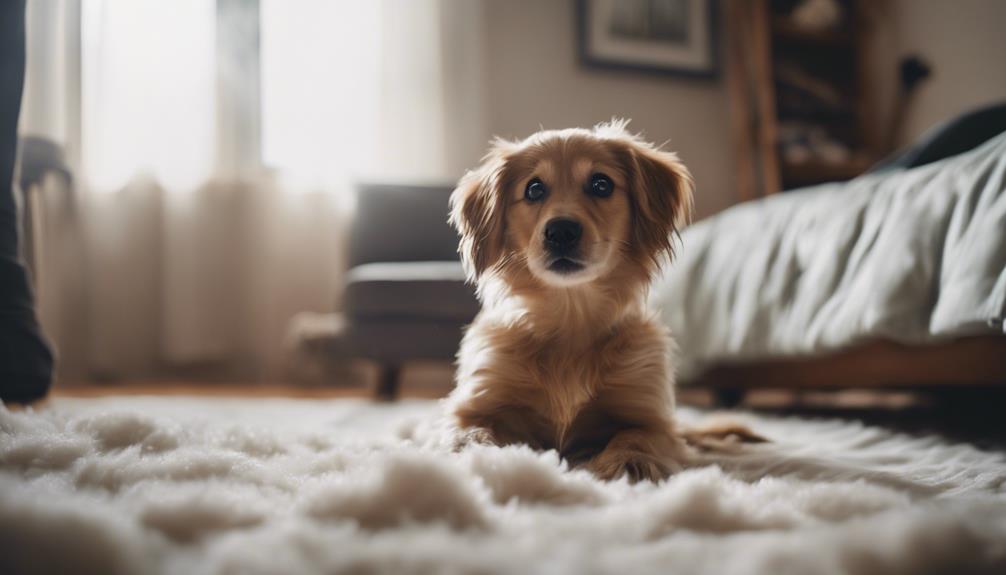
Young dogs facing housetraining challenges often exhibit inappropriate urination behaviors, including peeing on down comforters. This behavior can be attributed to a combination of factors such as the dog's young age, lack of bladder control, excitement, and anxiety. The soft and inviting texture of down comforters may also attract young dogs to pee on them.
To address this issue, it's essential to provide consistent potty training and supervision. Understanding the developmental stages of puppies can also aid in addressing incidents of peeing on the bed, including down comforters. By implementing effective training strategies and being patient with the housetraining process, pet owners can help young dogs learn appropriate bathroom behaviors and prevent them from urinating on household items like down comforters.
Environment Changes Triggering Peeing
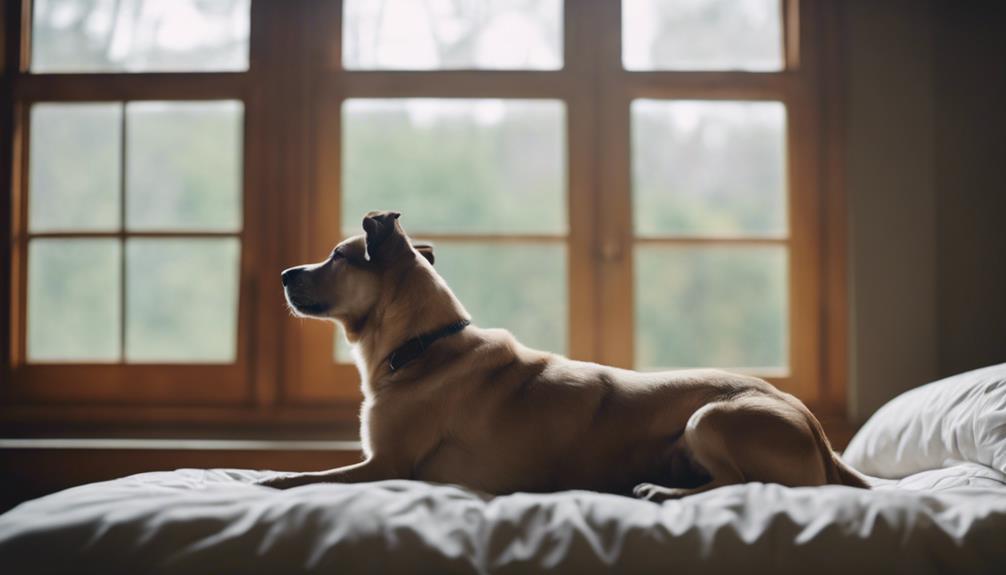
When experiencing changes in their living environment, dogs may exhibit peeing behaviors on down comforters. Dogs are sensitive to alterations in their surroundings, and environmental changes can trigger them to urinate in unexpected places.
Here are a few reasons why dogs might pee on down comforters due to environmental triggers:
- Moving to a New Home: Dogs may feel stressed when adjusting to a new environment, leading them to mark their territory by urinating on down comforters.
- Loud Noises: Sudden loud noises like thunderstorms or construction work can startle dogs, causing them to seek comfort and security by urinating on familiar items like down comforters.
- New Pets or Visitors: The introduction of new pets or visitors into the home can disrupt a dog's sense of routine, prompting them to exhibit marking behaviors on down comforters.
- Access to Your Bed: Allowing your dog access to your bed, especially during times of change, may lead to territorial marking through urination on down comforters.
Understanding these triggers can help pet owners create a stable and calming environment for their dogs, reducing the likelihood of accidents on down comforters.
Addressing Stress-Induced Peeing
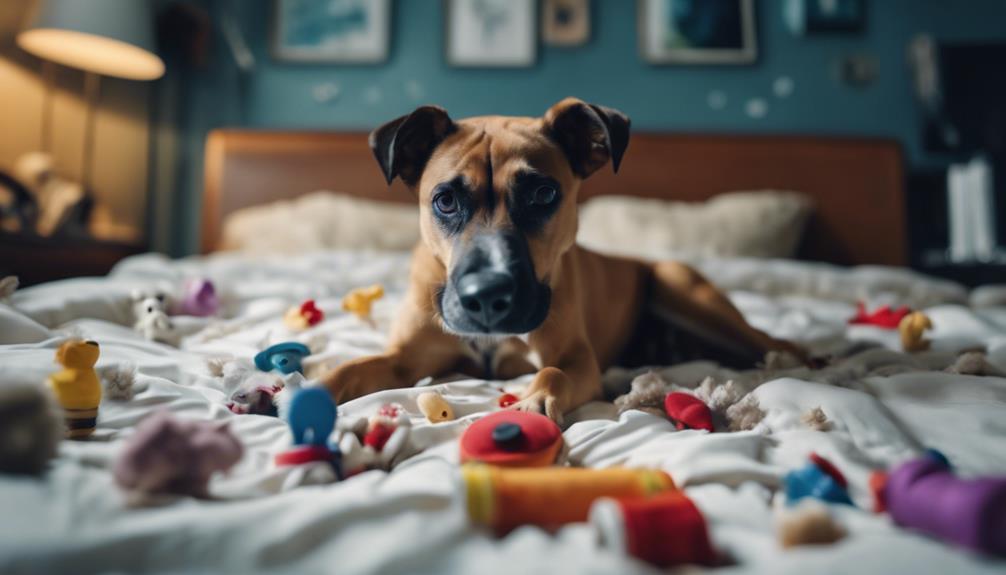
Experiencing stress-induced peeing in dogs due to environmental triggers calls for proactive measures to address and alleviate their anxiety.
When our furry companions exhibit this behavior, it's essential to address the root cause to prevent further accidents on down comforters.
First, identifying stressors like loud noises, unfamiliar visitors, or changes in routine is key. Once identified, creating a safe and calming environment can make a significant difference.
Consistent routines, positive reinforcement, and comforting strategies help reduce stress levels. When accidents happen, prompt action to remove urine and neutralize odors is vital to prevent re-marking.
Training sessions focusing on reinforcing positive behaviors can aid in teaching dogs appropriate bathroom habits. By taking these steps, we can help our dogs feel more secure and reduce the likelihood of stress-induced peeing on down comforters.
Establishing a Secure Home Environment

To create a secure home environment for your dog and prevent them from peeing on down comforters, it's essential to implement positive reinforcement techniques and provide a calm setting. When setting up your home for your furry friend, make sure to contemplate the following:
- Designate a Safe Space: Create a comfortable and quiet area where your dog can retreat to when feeling overwhelmed or anxious.
- Establish a Routine: Dogs thrive on routine, so make sure to adhere to a consistent schedule for feeding, potty breaks, and playtime.
- Use Interactive Toys: Provide your dog with mental stimulation through interactive toys to keep them engaged and prevent boredom.
- Maintain a Clean Environment: Regularly clean up accidents with enzymatic cleaners to remove any lingering scent that might encourage re-marking.
Frequently Asked Questions
Why Does My Dog Pee on My Comforter?
Dogs may pee on comforters for various reasons like excitement, marking territory, or stress. It's crucial to understand why your dog might be exhibiting this behavior. Factors like changes in their environment or health can contribute.
To prevent this, training and creating a stress-free environment are key. Using waterproof covers and proper cleaning methods can also discourage your dog from peeing on comforters.
How to Treat Dog Pee on Down Comforter?
To treat dog pee on down comforters, start by spot-cleaning with absorbent towels and enzyme cleaners. Rinse, dry, and launder the comforter multiple times.
Dry it outside in the sun to remove odors. Use a waterproof cover for protection.
Regularly use baking soda and white vinegar for odor removal. Follow these steps to effectively deal with dog pee on down comforters and maintain cleanliness.
How to Stop a Dog From Peeing on Blankets?
To stop a dog from peeing on blankets, provide consistent bathroom breaks, use positive reinforcement training, and keep blankets out of reach when not in use. Address any medical issues causing accidents and consider using waterproof covers for protection.
Training and prevention methods help establish proper elimination habits. Consistency is key in reinforcing good behavior and preventing future accidents. Implement these strategies to promote appropriate urination habits and protect your blankets.
Why Would a Dog Pee on a Pillow?
When a dog pees on a pillow, it could be due to various reasons, such as marking territory, anxiety, or medical issues. Understanding the underlying cause is essential to address this behavior.
Training, creating a stress-free environment, and regular vet check-ups can help prevent this. Waterproof covers can also protect pillows.
Is Peeing on Down Comforters a Common Behavior in Dogs?
It can be frustrating when a dog pees on comforter, but it’s not uncommon behavior. Dogs may mark their territory or have accidents due to anxiety or health issues. Training, routine bathroom breaks, and addressing any underlying issues can help prevent this behavior.
Conclusion
To sum up, understanding why dogs pee on down comforters can be complex. From anxiety and territorial marking to health issues and training challenges, there are various factors at play.
By implementing proper training techniques, addressing stress triggers, and creating a secure home environment, we can help prevent this behavior.
Remember, with patience and consistency, we can tackle this issue head-on and create a pee-free paradise for our furry friends.

